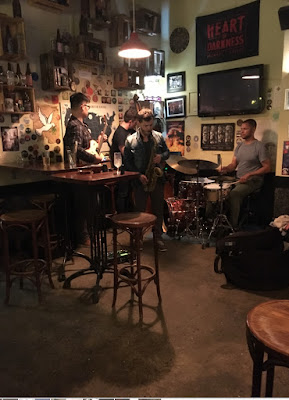The music of Lennie Tristano holds a special place in my heart. No one told me to listen to him, I discovered him largely my accident - hearing Lee Konitz on Birth of the Cool was the kicker. That led to the recordings on Capitol, which remain some of my all time favorites - "Intuition" and "Digression" blew my 18-year old mind and they still do today. My interest continued to grow as I saved up busking money to buy the Atlantic set on Mosaic records. The exchange rate at the time made it horrendously expensive - but worth it!
Considering what Tristano's music means to me, I really haven't written much about him. That's true for a few other musicians that have affected me on a very deep level (Connie Crothers and Richard Tabnik). Maybe in time I will write more about them too, it just hasn't happened yet.
There was that period where it was rather hip to name drop Tristano (and/or Warne Marsh & Lee Konitz) as an influence. I don't hear it nearly as much nowadays. For the most part, it was simply a name drop, as any influence I could hear was largely superficial if it existed at all. And I'm not only taking about nuts and bolts (notes, rhythm, harmony) but aesthetics too. And while the name-droppers got some attention those with deep connection to Tristano were for the most part ignored.
For the week leading up to what would have been his 100th birthday, I've listening to Descent Into The Maelstrom. It's great the album has finally been re-issued by Jazz Records Inc. (the label founded by Tristano in the early 50s) - hopefully they delve into the archive and provide us with a few more gems. Originally released in the 1970s it features tracks selected from various sessions in the 50s and 60s.
Considering what Tristano's music means to me, I really haven't written much about him. That's true for a few other musicians that have affected me on a very deep level (Connie Crothers and Richard Tabnik). Maybe in time I will write more about them too, it just hasn't happened yet.
There was that period where it was rather hip to name drop Tristano (and/or Warne Marsh & Lee Konitz) as an influence. I don't hear it nearly as much nowadays. For the most part, it was simply a name drop, as any influence I could hear was largely superficial if it existed at all. And I'm not only taking about nuts and bolts (notes, rhythm, harmony) but aesthetics too. And while the name-droppers got some attention those with deep connection to Tristano were for the most part ignored.
The title track is a wonderful reminder of what a visionary Tristano was. In the early 50s many were still trying to come to terms with Bird, yet Tristano was blazing a path of his own. It's a shame it stayed unreleased until 1976, I wonder what the reception would have been like in 1953?
"Stretch", from 1966, is another track I have listened to a lot over the years. It was introduced to me during my studies with Richard Tabnik [one of the highlights of studying with RT was hanging out and listening to records.... everything from Prez to Lenny Bruce to Zappa to Konitz to Armstrong to The Beatles to Bach to Lenny Popkin and more!]. The drive is reminiscent of his work at the Half Note on Continuity (which also featured the pairing of Sonny Dallas and Nick Stabulas on bass and drums).
The interweaving lines on "Pastime" was something that grabbed me this week. It reminds me a little of his trio sides from the 40s moreso than the slightly later Capitol sides. I like the way he and Billy Bauer (the forgotten man of jazz guitar?) bounce off each other on those trios sides. The recordings of the trio from the 40s tend to be overshadowed by his later work, but don't sleep on them! But here, and on "Ju Ju", Tristano weaves contrapuntally with his own overdubbed lines. I'd have to look it up, but I think those two overdubbed tracks kind of slipped under the radar when they were released. Not so once Tristano was recording on Atlantic. It's funny how, due to the overdubbing, there was uproar when Tristano released "Line Up", yet less than 8 or 9 years later Bill Evans wins a Grammy and gets a 5-star review for Conversations with Myself."
There are times when I have binged on all of his recordings (the last time was probably with the release of Chicago April 1951). Do I listen to his music as much as I used to? No, these days I'm more likely to listen to a track or two here and there. But his music still travels with me every day, and it still thrills me.





